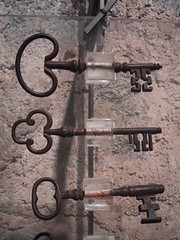Before we get into the 5 places you MUST use keywords, make sure you’re familiar with how to blog for your business. When you feel comfortable with the concept of keywords, we’ll get started on how to use them in your blog.
Does It Matter Where The Keywords Go?
Yes. Think of it like a lab report. Did you ever do one of those in high school or university? It doesn’t matter how great your content or results are – if you don’t format it in the right way, you lose marks.
So where do your keywords go?
Good question. After you’ve picked your keywords using an application like the Google AdWords Keyword Tool, it’s time to write your blog. There are 5 places you absolutely MUST use keywords to make sure that you have the best chance to rank for that word. If you don’t place keywords properly, Google will have a hard time figuring out what you do, which means your keyword research will be, well, a bit of a waste.
5 Places You MUST Use Keywords
Luckily, the 5 places you must use keywords are easy to do. In fact, you’re already doing all of these things without even thinking about it – we’re just going to fine tune it.
1) Blog Post Title
Your blog post title tells your readers and Google what the article’s about – use keywords in the title to make it as clear as possible. As a guideline, start with the keyword and then make it enticing. For example, if your keyword is “great purple bananas” your title could be “Great Purple Bananas Are Taking Over The World”.
TIP: Don’t get too fancy with your titles – while they can be funny, make sure they’re not confusing for people and search engines.
2) Content – The Body Of Your Post
This is the heart of your blog post, so make sure your keyword is well represented. Use your keyword at least twice in each post. This should be easy, as you’re writing about the topic and the keyword will come up naturally. If you feel the keyword isn’t appearing often enough, you can go back and add it in where appropriate – the more times you use a keyword, the better.
Actually hang on. That’s not true. Don’t try and “stuff” keywords into your post just for the sake of it. Google is smart and can sniff out bad blogging practices like this in a jiffy. If you don’t feel there’s anywhere else the keyword should be, you’ve done everything you can do. Time to move on.
3) URL aka “www.something.com”
Make sure your keyword is in the URL, which is the link to the page. You should also remove junk like random numbers. Why does this matter? Well, the URL of a post is important for 2 reasons:
1) Short and concise URL’s are easier for people to share
2) URL’s with lots of numbers and other junk are confusing for search engines
If you’re using a blogging platform like WordPress, changing the URL is easy. Click the “edit” button and change it to whatever you want. You can also use quotations instead of dashes to make it easier for people to read your URL.

Tip: If you change the title of your post, make sure you update the URL because sadly WordPress won’t do this for you.
4) Sub-Headings
Headings are an easy way to help people scan your blog and find content they’re looking for. Plus, they’re one more thing that tells search engines what your article is about. You can change the heading size in your blogging platform (top left corner if you’re posting with WordPress).

Tip: The headings are numbered, usually 1 to more than 1. The most important header for Google is h1, and in this case h6 is the least, so make sure you use h1 for the most important titles.
5) Photos
While you and I can look at an image and see what it is, Google has a hard time. For the sake of making a point, pretend Google is blind and can only read braille. The best way to tell Google what’s on an images is by filling in the “title” and “alternate text” descriptions. If you’re using a blogging platform, you can add the information as you upload the photos to the page.

Make sure you include the keyword in the description to, once again, tell Google what’s on your page and what that image is about. For example, if you’re writing an article about purple bananas and you upload a photo of a huge purple banana in Manhattan, you could fill in the title and alternate text as “A huge purple banana squashing cars in Manhattan.”
Tip: Make your title and alt tags the same.
Your Turn
Alright, now you know the 5 places you must use keywords, it’s time for you to try it out for yourself. Feel free to go back and edit some of your older posts so you can get the hang of it.
